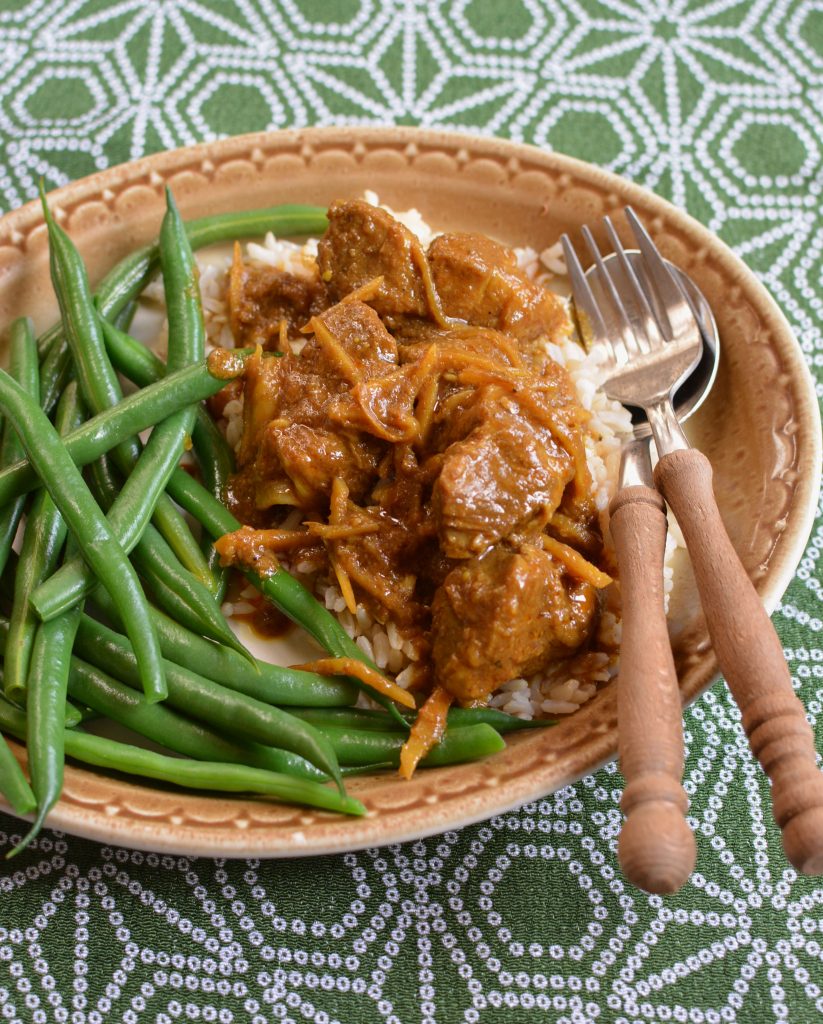
You don’t have to take a fifteen-hour bus ride from Bangkok to mountainous Mae Hong Son City to taste kaeng hang lay tai curry (แกงฮังเลไต), one of northern Thailand’s most popular dishes. Just open Austin Bush’s new cookbook and head to the supermarket for the ingredients!
Purity and detail fill his book. He wrote the recipes as he learned them from local experts, and includes history and cultural information, making you realize the fluid manner in which ideas traveled throughout Southeast Asia to be adopted and adapted in people’s kitchen.
Mae Hong Son province abuts Myanmar (formerly Burma), and the Burmese occupied northern Thailand from 1558 to 1775. They introduced hang lay curry, and within the northern Thai repertoire, the earthy, spiced curry is second to khao soi noodle soup. It’s devoid of coconut milk and employs dry spices, evoking the Indian influence on Burma. There are many renditions of kaeng hang lay and Bush includes two (2!) recipes in The Food of Northern Thailand to underscore the dish’s ubiquity. He’s lived in Thailand for decades and speaks the language fluently. Bush has written for travel books and now stepping into the realm of cookbook writing.
The Food of Northern Thailand has gorgeous illustrations of maps and techniques, as well as location photos that Bush took. The writing is chock full of information for anyone interested in Southeast Asian foodways.
The Shan people, a Burmese ethnic community related to the Thai, shape the cuisine and culture of Mae Hong Son province. Bush specifies that kaeng hang lay tai is a Shan-style pork belly curry and he traveled to Mae Hong Son City to obtain a true recipe. (If you have the Burma Superstar cookbook, the Pork Curry with Green Mango Pickle recipe on page 36 has similar ingredients to this!)
Why Use Supermarket Ingredients for ‘Exotic’ Fare
I picked the kaeng hang lay tai recipe to prepare because I’d had a so-so restaurant version and wanted to make it better. More importantly, Bush’s recipe was simple and easy to make from American supermarket ingredients. Even ketchup and Sriracha are used!
A central part of my R&D for Vietnamese Food Any Day has been figuring out smart mainstream workarounds to make good Asian food. That means checking out supermarket inventories and identifying suitable substitutes. I’ve become versed in doing this because if I’m going to inspire more cooks to explore Asian cuisines, I should make the ingredients as accessible as possible but not to dumb things down. Not everything is possible but lots is.
Ingredient Subs that Don’t Compromise
With respect to the kaeng hang lay tai recipe, I identified some easy subs that didn’t compromise flavor. For example:
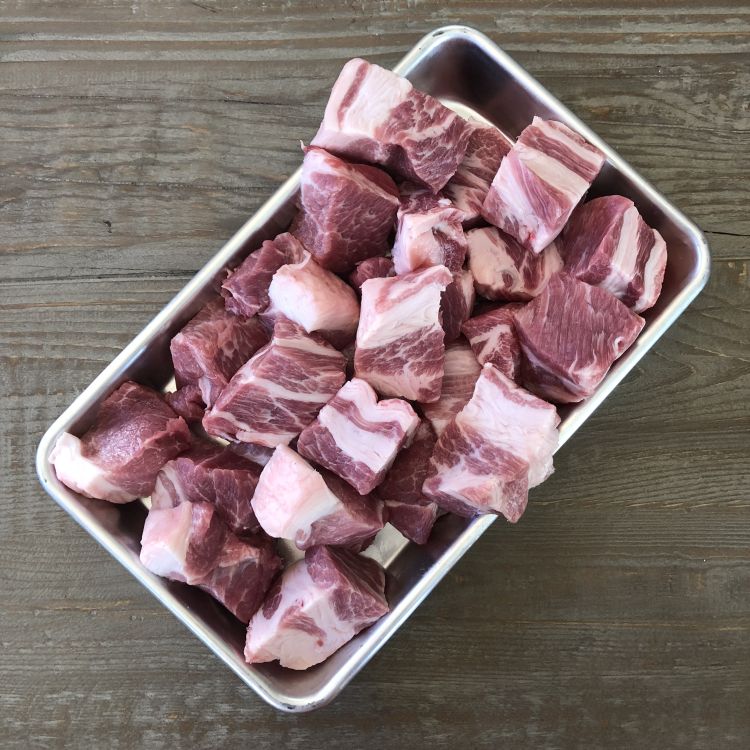
Bush’s recipe calls for skin-on pork belly. What’s sold at my local butcher counter is very fatty with little meat. As a result, I bought a fatty chunk of pork shoulder and cut it so each piece had some fat and lean. The dish is rich with pork fat, which I removed about half after refrigerating the finished curry (below).
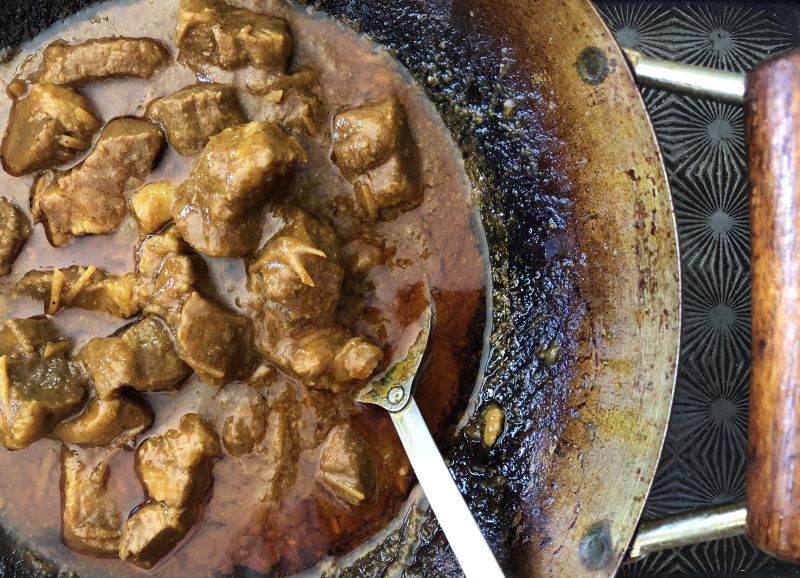
Thai shrimp paste (gapi) is mellower than Vietnamese mam tom but I’ve recently found that anchovy paste is a great substitute in a 1:1 ratio. The funky adds umami depth not fishiness. Pack the measuring spoon with anchovy paste. Of course, you can add a little later on.
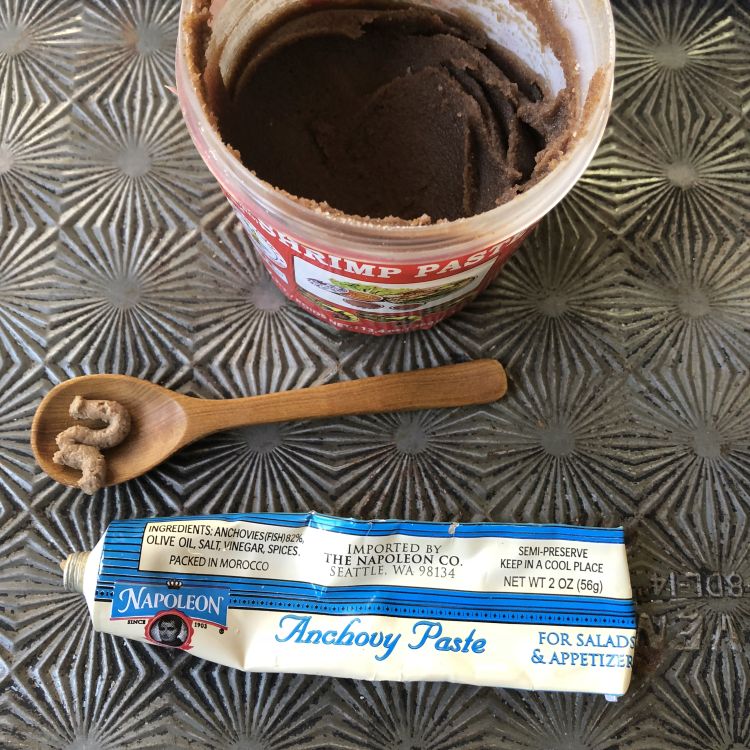
Sticking with a Thai rubric, Bush refers to light and dark Chinese-style soy sauces as white and black soy sauce. The difference is in the color, not sodium levels. For light soy sauce, I use a regular soy sauce like Kikkoman. If you see Pearl River Bridge in the Asian aisle, that’s better stuff! For the dark soy sauce, use regular soy sauce but cut it with molasses to mimic the sweet thickness. In the kaeng hang lay tai curry, the soy sauces aren’t pivotal. Ditto for Maggi, which you may have but Bragg Liquid Aminos is gluten-free, domestic substitute that I regularly reach for at the supermarket.
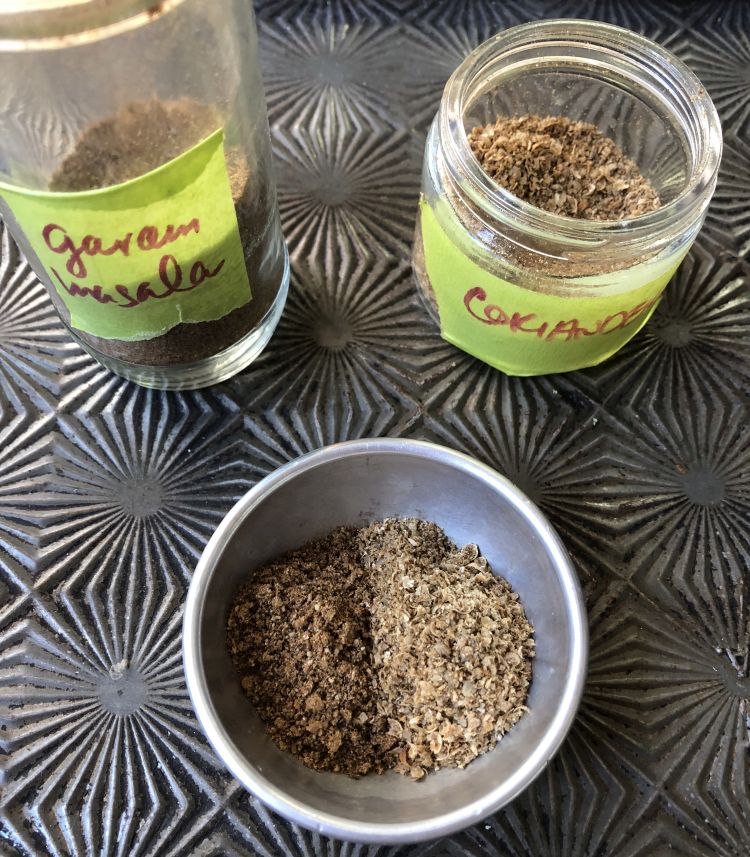
The hang lay powder (a spice blend) is complicated but tucked into its lengthy description was Bush’s substitute formula: 1 + 1 – and equal volume of garam masala and ground coriander. So for the 1 tablespoon, I just combined spices from my pantry.
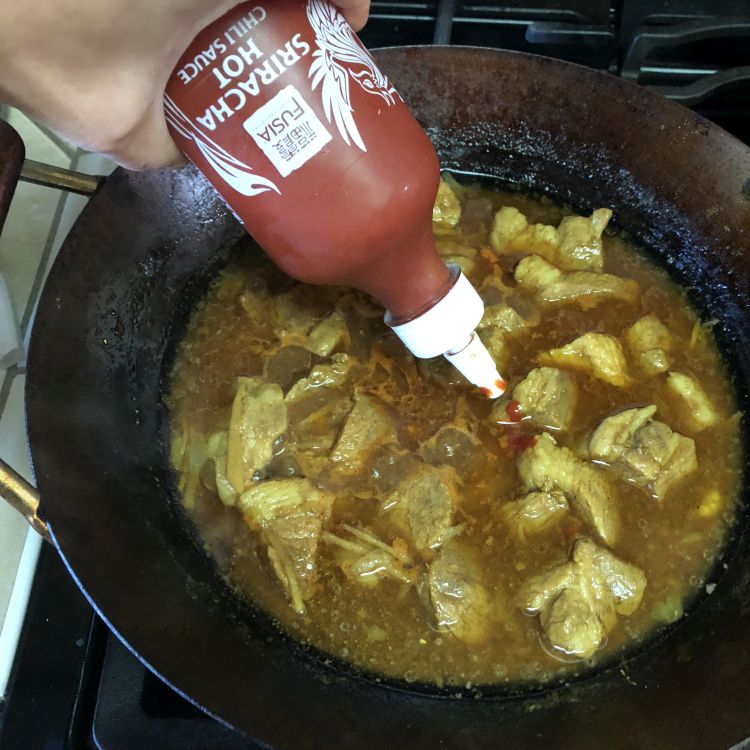
When looking for a mild Southeast Asian chile sauce, I grabbed Fusia, a brand that’s exclusive to Aldi; Fix sold at Whole Foods is good too. Akin to the Shark brand Bush referenced in the original recipe, both are mellower than Huy Fong’s Rooster brand. Plus, they’re made in Vietnam too!
The trickiest ingredient to obtain is tamarind. It lends tang and body to the curry. Use a slab like what’s used for the date and tamarind loaf cake recipe. I recently spotted fresh sour tamarind pods at one of our larger Safeway supermarkets and shelled about half a pound. Not all supermarkets have tamarind but you never know until you look in the produce or Asian aisle.
Not all cooks will translate a seemingly exotic and unfamiliar recipe like I do. But hopefully, I’m equipping you with some swaps that you can apply here and elsewhere. Knowing how to make smart substitutes suddenly makes a whole world of new dishes possible.
Books like The Food of Northern Thailand offer ideas that may seem daunting and foreign, but you can make some of the food with relatively ease. American supermarkets and online retailers make that possible more now than ever.
Related posts and resources
Kaeng Hang Lay Tai
Yield 4 to 6 servings
Kaeng hang lay tai is super easy to prepare because the pork is merely simmered in liquid and seasonings and aromatics are added in phases. That means you can prep as you go along! There’s little advance work to do.
Serve this Shan-style pork and tamarind curry with rice and a vegetable like boiled green beans. A little goes a long way to flavor the rice. I’ve adapted Austin Bush’s recipe from The Food of Thailand by including my supermarket substitutes in parentheses and in ingredients that say “or XXX”. The recipe is traditionally made in a medium wok (about 12 inches wide) but you can use a 3 or 4-quart casserole-style pot. Refrigerate the curry for a few hours and remove some of the fat, if you like. It’s suppose to be rich so don’t go too far.
Ingredients
- 3 ½ ounces tamarind pulp, broken into 3 or 4 chunks (if using fresh tamarind pods, shell about 8 ounces of sour pods to obtain the amount needed)
- 1 ¾ pounds pork belly (including fat and skin) or fatty pork shoulder, cut in sections approximately 1 inch wide and 2 inches long
- 1 teaspoon turmeric powder
- 1 teaspoon ‘black’ soy sauce, or ¾ teaspoon regular soy sauce plus ¼ teaspoon molasses
- 1 teaspoon shrimp paste or anchovy paste
- 1 ½ ounces shallots, eeled, halved and sliced lengthwise
- 5 garlic cloves
- 1 ¾ ounces ginger, peeled and julienned
- 1 teaspoon ‘white’ soy sauce or regular soy sauce
- 1 teaspoon Maggi Seasoning liquid or Bragg Liquid Aminos
- 1 tablespoon oyster sauce
- ½ teaspoon chicken bouillon powder or base (such as Knorr or Better Than Bouillon brand)
- 1 teaspoon sugar
- 1 tablespoon hang lay powder, or 1 ½ teaspoons garam masala plus 1 ½ teaspoon ground coriander
- 1 tablespoon ketchup
- 1 tablespoon mild chili sauce (such as Shark, Aldi, or Fix brand Sriracha sauce), or 2 teaspoons Huy Fong Sriracha
Instructions
- Bring ½ cup of water to a boil in a small saucepan over medium heat. Add the tamarind pulp and mash with a spoon to combine. Set aside for at least 15 minutes.
- Place the pork belly, turmeric powder, ‘black’ soy sauce, and shrimp paste in a medium 12-inch-wide wok (or use 3 or 4-quart pot). Add enough water to nearly cover the pork. Cover with a lid and bring to a simmer. Reduce the heat to low and simmer, covered, for 10 minutes, stirring occasionally. Stir the shallots, garlic, and ginger into the wok. Simmer, uncovered, another 20 minutes, to reduce the liquid slightly. Stir in the ‘white’ soy sauce, Maggi, oyster sauce, stock powder, sugar, hang lay powder, ketchup, and chili sauce. Simmer, uncovered, another 20 minutes, at which point the liquid should have reduced by a quarter or a third of its original volume, the pork should be starting to become tender, and a thin layer of oil should begin to appear.
- Using a spoon, mash the tamarind pulp again and strain the liquid through a sieve into the pork mixture, pressing to extract as much liquid as possible, discarding the solids. (You can opt to strain the tamarind into a cup or bowl, then pour into the wok.) Simmer, uncovered, until the pork is tender but not yet falling apart, another 10 to 20 minutes.
- Taste, adjusting the seasoning if necessary; the kaeng hang lay tai should be relatively thick in consistency and dark in color, and should taste predominately tart and of umami, followed by salty and sweet.
- Remove to a serving bowl and serve warm or at room temperature, with long-grain rice, as part of a Shan meal.
Cuisine Thai













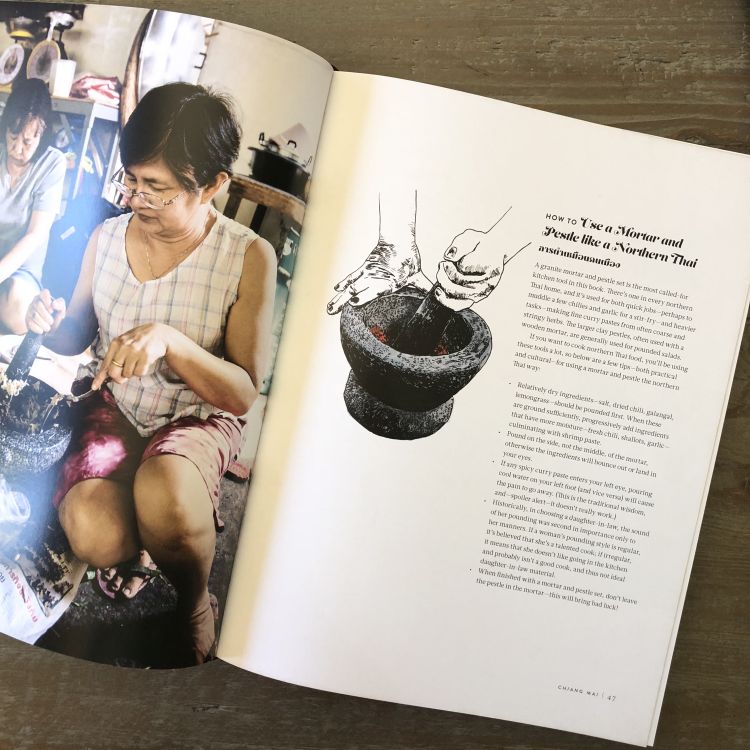
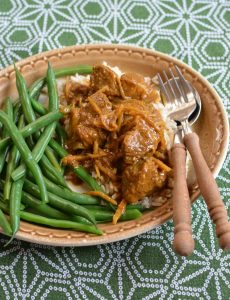




Jaycie from Vermont says
This was AMAZING! The whole family ate it, even the picky one! It was gone almost before the rice was even finished cooking. They are begging for me to make it again this week. As I write this, my husband is asking if he can lick the bowl.
I had to make a few substitutions: fish sauce for the anchovy paste (so I doubled it), and I did not have the amino liquid, so I added a little extra black soy sauce, a tsp of Worcestershire sauce and doubled the Better than Boullion. I also cut back on the tamarind (I tasted and added the tamarind slurry until it was how I wanted it). I also used 2 lbs chicken thighs.
Andrea, I have made several recipes from your blog. I appreciate how you explain ingredients, and give suggestions for substitutions. I live in a rural area where it is hard to get many authentic ingredients.
Many of your recipes are well loved in our home, and have entered my meal rotation. But THIS was the icing on the cake! Thank you for sharing!
Andrea Nguyen says
Jaycie, thanks for making the recipe and then taking time to write! I'm so happy to get your feedback, especially because you live in a place where ingredients can be hard to source.
You made my day!
Andrea
Mira Edorra says
This is awesome! The combination of flavors sounds like a great authentic taste. I love everything about this recipe, need to try this!